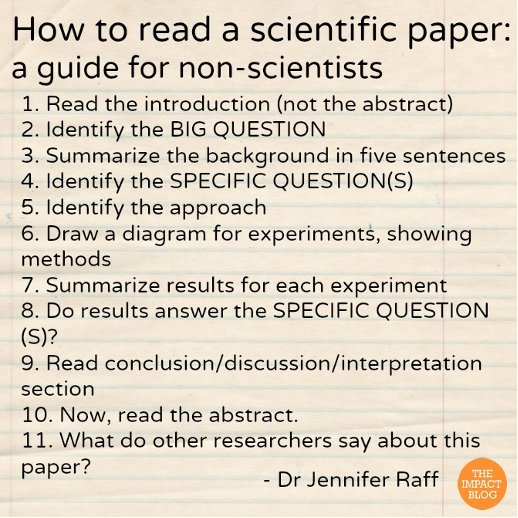In our day-to-day practice of therapy, running from one session to another – often from one side of the city to the other it is so easy to focus on the day to day and the current session, assessment or intervention rather than the bigger picture. Add KPIs, deadlines and last minute “can you just?” requests from coordinators, planners and team members – there is literally sometimes not enough hours left in the day, let alone time to prioritise reading a journal article. The truth of the matter is that we need to make the time to read appropriate material as it does ensure we are providing best practice and helps us to ensure we can make sense of product specifications and can relate these to evidence based practice.
Let’s also be honest here. Reading journal articles can be hard, tedious and sometimes make you feel less than intelligent. I mean why can’t researchers just tell it like it is? Or write in simple English? The fact that articles can be either hard to find, cost money to access and then be difficult to understand adds to the additional perceived barriers to why you may not read more articles than perhaps we should.
I would like to think that I am reasonably intelligent – but sometimes when I pick up an article to read, I feel like I am really struggling to understand or keep up with the article. As I have caught myself making a number of excuses as to why I shouldn’t or couldn’t read an article or two recently I thought that I would see what others have to offer on the topic with the hope that they would either make me feel better or give me a strategy or two to make my reading, understanding and application of the research easier.
In my search for inspiration and insight I stumbled across an article written by Adam Ruben How to read a scientific paper | Science | AAAS. My thanks and heart go out to Adam after reading his article, as I was able to totally relate to his story of having read a number of papers but not being able to answer specific questions when asked. Unfortunately, he did not have a simple answer for me BUT he did provide some great insight – and his 10 Stages of Reading a Scientific Paper were very relatable. I personally could relate to Bafflement, Distraction and Rage. All emotions often experienced when reading journal articles.
What Adam did make clear is that firstly, practice makes perfect. The more we read (and I mean really read) the easier journal articles are to understand. And how do we ‘really” read an article? Well – Adam’s advice; look up every single word and acronym that you do not understand and ensure you understand every sentence before you move onto the next. Whilst this is tedious and time consuming – he makes a valid point. This will pay off, especially if we have a nose buried in similar topics on a regular basis. Every future paper will become easier to understand and slightly faster as over time we will need to look up less and less.
Dr Jennifer Raff also provided an interesting insight into how we should be reading journal articles. The key take-home from her advice is to not read the abstract first. In fact, this is the last part of the paper that we should read as the abstract is where the researchers present their own summary of their own work. At times, there can be a bias in the abstract – which is why as readers we should not let this sway our own thoughts, findings and questions. Dr Raff suggests that we should first start with the introduction and ask ourselves not “what is this paper about” BUT “What problem is this entire field of study trying to solve?” What exactly are the authors seeking to answer with their research? She encourages us to write down the questions, so we are clear before we jump any further into the article.
To assist getting our heads around the method section she suggests that we draw out (as in pen and paper and a colored pencil or two) the experiment so that we can understand how the experiment was undertaken. Similarly, to Adam Rubens advice – the common theme here is take the time to understand what you are reading 100%. Draw it out, look it up. Just find a way to make sure you really get it.
Dr Raff’s step by step guide on how to read an article can be accessed here: How to read and understand a scientific paper: a guide for non-scientists | Impact of Social Sciences (lse.ac.uk). But simply summarized:

Another great resource if you want to learn to break down each section of a research paper is the book ‘How To Read a Paper’ by Trisha Greenhalgh. This is a really insightful book, where Trisha dedicates each chapter to different types of papers and what each section in those papers are.
So now we have a couple of tips and tricks to try to help us overcome the barriers to reading and understanding a paper, why is it so important that we spend the time? Firstly – best practice. We want to make sure that the equipment we are prescribing is best practice and most appropriate for the user. In the world of Assistive Technology however – being up to date with research also helps us to make sure what is being claimed of the product is actually true. I always like to read the research behind a claim – as I want to be sure that creativity or a marketing perspective has not impacted the clinical implication. It is also a great habit to get into as it is good to know who has done the research and what is the quality of the paper. Essentially, ask yourself – Is this paper reliable and can I trust it?
Finally, when applying for funding we need to demonstrate that what we are recommending is best practice. The more up to date we are on current research and best practice - the easier it is and more confident you will be in your prescription.
Reference list:
Greenhalgh, T (2014). How to Read a Paper: The Basics of Evidence-Based Medicine. BMJ Books.
Reuben, A. (2016). How to Read a Scientific Paper. Science. Accessed 17 November 2021. doi: 10.1126/science.caredit.a1600012
Raff, J. (2013). How to Read and Understand a Scientific Paper. A Guide for Non-Scientists. Accessed 17 November 2021 How to read and understand a scientific paper: a guide for non-scientists – Violent metaphors

Tilly Brook
Clinical Services Specialist
Permobil APAC
Tilly Brook graduated from the University of Adelaide in 2008 with a Bachelor of Health Science followed by a Masters of Occupational Therapy (Hons) in 2010 from the University of Sydney. Tilly worked within rehabilitation, working primarily with adults with a brain injury until 2015 when she moved to Singapore. In Singapore, she worked with children and adults at the Cerebral Palsy Alliance School (CPAS). In 2017 Tilly’s clinical knowledge continued as she worked with Mobility Solutions in Auckland, New Zealand. On her return to Australia, Tilly assisted in the development of the Clinical Hub Team at Sunrise Medical where her passion and experience for mentoring and educating therapists grew. Tilly Joined Permobil in January 2022 and is driven to grow therapists, enabling them to be the best therapist they can be.
